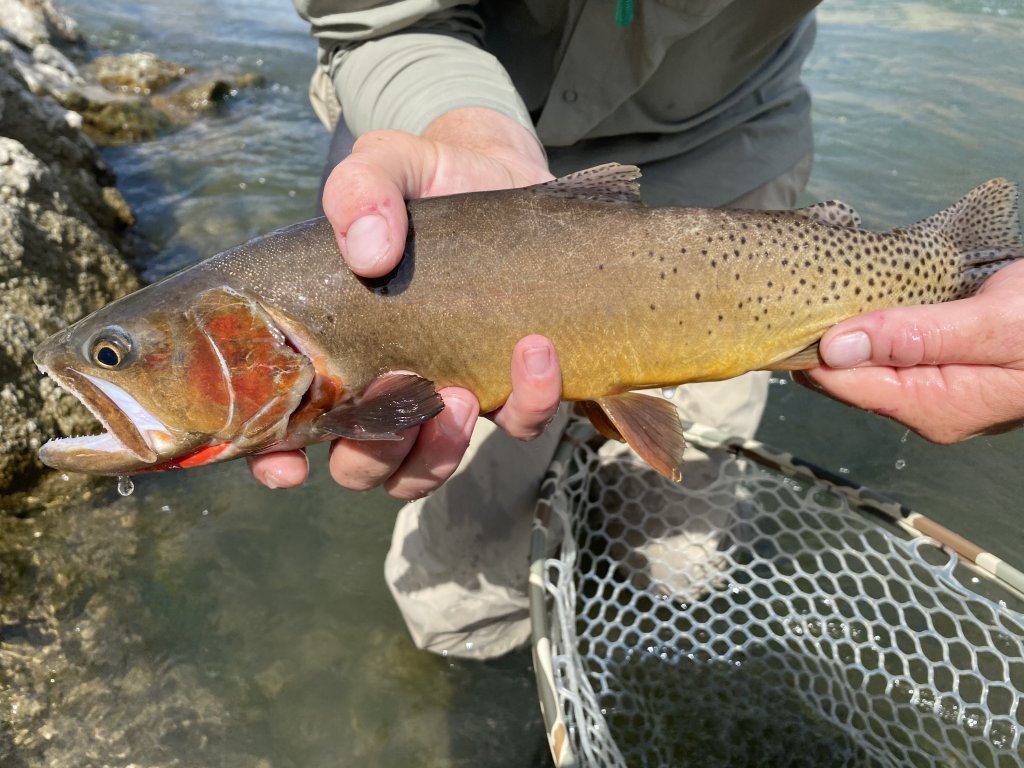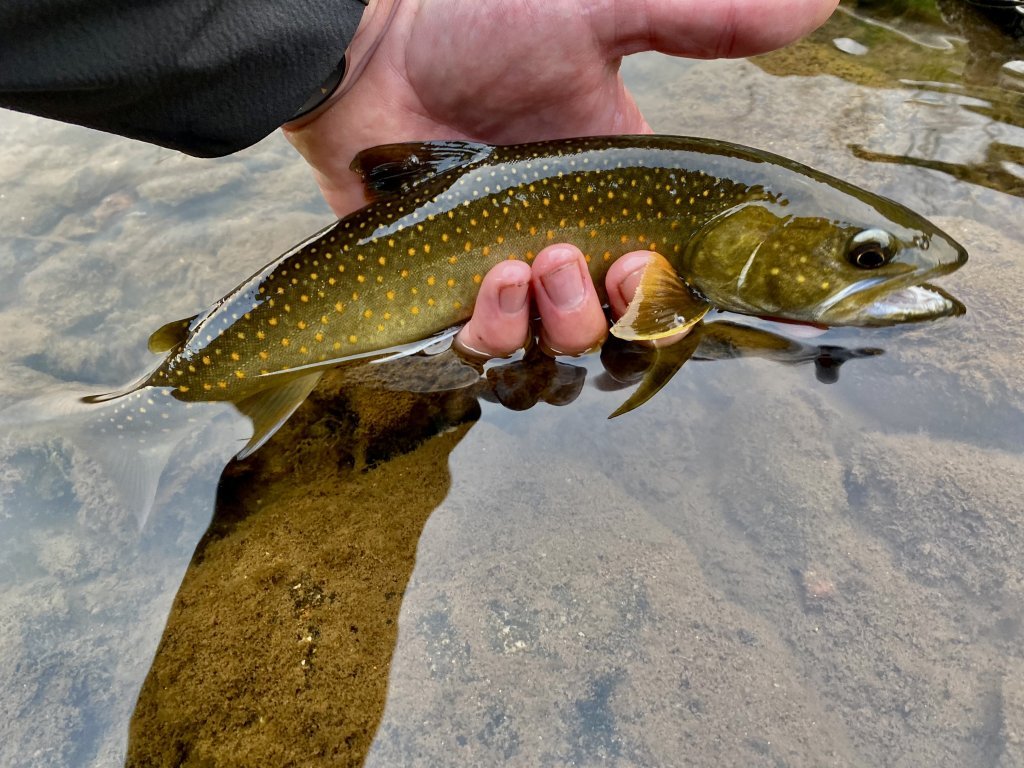
Try Your Own Idaho Native Trout Road Trip
For Visit Idaho - October 2021
Whether you’re a life-long angler looking to complete the Idaho leg of your Western Native Trout Challenge or a first-timer interested in gaining a better understanding of Idaho, a road trip to experience its native species is a sure-fire and fun way to appease your curiosity.
Daniel Ritz worked in partnership with Visit Idaho to create this Travel Tip.
Thankfully, many of Idaho’s more than 100,000 miles of rivers, 891 miles of which are designated as Wild and Scenic, are flanked by major travel corridors, enabling an unparalleled travel experience for curious anglers.
In addition to the abundant well-known and world-class fisheries like Henry’s Fork of the Snake River and Silver Creek, the lesser-discussed fact is that many of these easily accessible aquatic corridors are home to one or more of the five native species of trout found in the Gem State, second only in native trout species diversity to Alaska and California.
Redband Trout. Photo credit: Daniel Ritz.
Why are native species important?
In addition to their unique ecological value, the pursuit of these species offers anglers much more than the temporary satisfaction of a tug on the end of the line. Engaging with native species in a responsible manner enables anglers to step beyond simply tossing a fly (or lure) in the water and seeing what happens. Pursuing native species elevates fishing to an experience.
Whether you’re a life-long angler looking to complete the Idaho leg of your Western Native Trout Challenge or a first-timer interested in gaining a better understanding of Idaho, a road trip to experience its native species is a sure-fire and fun way to appease your curiosity.
If you’re interested in creating and completing your own “Idaho Native Trout Slam” here’s one route, based on seasonal fishing trends, that I’d suggest.
Redband trout. Photo credit: Daniel Ritz.
Stop 1: Southwest Idaho
Species: Redband trout (Oncorhynchus mykiss gairdneri)
Often mistaken for Rainbow trout, Redband trout are actually a subspecies of the rainbow trout that exist in two well-defined geographic regions. The Columbia River Redband Trout is found in Montana, Washington, and Idaho, and the Great Basin Redband Trout can be found in southeastern Oregon, Idaho and parts of California and Nevada.
The Redband trout is similar in appearance to the Rainbow trout but has larger, more rounded spots and parr marks that remain into adulthood.
Redbands are aggressive feeders, eager to take dry flies carefully placed in the pocket waters they inhabit. Be careful though, their small stature leaves them wary of predators and careful approaches and presentations are often necessary.
Redband trout’s centralized distribution makes them a fantastic way to start your native species road trip and leaves your options on where to go next plentiful.
Westslope cutthroat trout. Photo credit: Daniel Ritz.
Stop 2: Northern Idaho
Species: Westslope cutthroat trout (Oncorhynchus clarkii lewisi)
Traveling north, anglers will climb from the high desert of the more populous southwest into the pine-riddled National Forests and Wilderness of northern Idaho, including the Clearwater River drainage and the native waters of the Westslope cutthroat trout.
Clearwater River drainage area. Photo credit: Daniel Ritz.
Although commonly associated with the state of Montana, the historic range of Westslope cutthroat trout is the most geographically widespread among the 14 subspecies of inland cutthroat trout. In Idaho, Westslope Cutthroat Trout are native to streams and lakes in the upper Columbia River basin. Westslopes currently occupy about 59 percent of the nearly 56,500 miles of their historical habitat.
While it can sometimes be difficult to distinguish the Westslope from other cutthroat species, anglers can keep in mind that they generally have more small spots by the tail and none by the pectoral fins. The Westslope cutthroat trout often has more of a silver or green hue than the Yellowstone cutthroat trout they share geographic proximity with. The average size of these fish is 6 to 16 inches.
Yellowstone cutthroat trout. Photo credit: Daniel Ritz.
Stop 3: Eastern Idaho
Species: Yellowstone cutthroat trout (Oncorhynchus clarkii bouvieri)
The historical range of the Yellowstone Cutthroat Trout in Idaho was upstream of Shoshone Falls on the Snake River and tributaries. It also existed across the Continental Divide in Yellowstone Lake and in the Yellowstone River, and its tributaries downstream to the Tongue.
This makes Yellowstone cutthroat trout a fantastic way to share in the beauty and blue ribbon streams of eastern Idaho.
Yellowstone cutthroats can be distinguished from other cutthroat trout by their larger black spots, clustered toward the tail, and by their gray, gold, and copper hues. A mature Yellowstone cutthroat usually measures from 6 to 20 inches long.
Yellowstones are notorious for their eagerness to take dry flies off the surface and there’s not much better than seeing the vibrant cheeks of a Yellowstone rise out of iconic rivers such as the South Fork of the Snake River or the Teton River with the continental divide as a backdrop.
Bonneville cutthroat trout. Photo credit: Daniel Ritz.
Stop 4: Southeast Idaho
Species: Bonneville cutthroat trout (Oncorhynchus clarkii utah)
While Bonnevilles inhabit the smallest geographic range of any of the native trout of Idaho, their recovery in far southeast Idaho is an incredible example of collaboration and compromise.
Once thought to be extinct, after an aggressive, coordinated recovery effort by a multi-agency conservation teams and private citizens, there are now at least 202 Bonneville cutthroat trout populations that occupy about 2,728 miles of stream habitat in 21 watersheds in Utah, Idaho, Nevada, and Wyoming. A number of small streams, many of which are enveloped by the Cache National Forest, await anglers looking to catch this oft-forgotten native species.
Some populations within the Bear River drainage near the intersection of Idaho, Wyoming and Utah continue to exhibit the species’ impressive life history and habitat requirement diversity, migrating seasonally between lower elevation rivers systems and the cold, clear waters of high-elevation tributaries.
Bonneville can be identified by their spots; usually larger than other cutthroats and sparser as compared to rainbow.
Bull trout. Photo Credit Daniel Ritz
Stop 5: Central Idaho
Species: Bull trout (Salvelinus confluentus)
Thanks to largely interconnected waterways, Bull trout are widespread in Idaho. They are in most river drainages in central and northern Idaho that flow into the Snake and Columbia rivers.
They’re most common in coldwater rivers, which in summer often means upper-elevation streams. Bull trout need water that’s 60 degrees or cooler, and water that’s around 54 degrees is ideal habitat for them. Highly migratory, Bull trout can be a challenge to locate but anglers willing to put in the time to familiarize themselves with their movement patterns will find themselves in some of the most beautiful country in the state including the Frank Church-River of No Return Wilderness, the mighty Salmon River and the South Fork of the Boise River.
When bull trout were listed as threatened under the federal Endangered Species Act in 1998, the U.S. Fish and Wildlife Service determined Idaho Fish and Game regulations provided sufficient conservation benefits. In Idaho, that meant bull trout fishing was allowed, but harvest was not. Those regulations are still in place, so bull trout can be caught, but they must be immediately released unharmed.
In Idaho, Bull trout are often misidentified as Brook trout which are a non-native and invasive species in Idaho. Bull trout, Lake trout and Brook trout are all chars: members of the trout family with light spots on a dark background. The bull trout lacks black spots on the dorsal fin; the brook trout has these spots. That’s the best way to tell these two species apart. The lake trout can also be easily identified from Lake trout by its deeply forked tail.
The decision to pursue the native trout species of Idaho on a road trip can provide beginners and lifelong anglers alike with a life-changing crash course in natural history and conservation successes that you and your family are certain never to forget.
While little is guaranteed in fishing, I’m willing to assure you that a road trip to experience each of the native species of Idaho will leave you wondering not only just exactly what’s around the river bend, but what’s in it.
Be sure to visit Idaho Fish and Game, check the regulations, and a fishing license before you hit the road.
We’ll see you out there.
To learn more about where exactly you can find each Idaho’s native trout species, visit the ‘Fish Maps’ of the Western Native Trout Challenge hosted by Western Native Trout Initiative.
Feature image credited to Daniel Ritz.
Daniel A. Ritz is an outdoor journalist and writer based in Boise, Idaho. A former editor at the Dana Point Times, Ritz’s work has been published by Trout Unlimited, Orvis, the Western Native Trout Initiative, Backcountry Hunters and Anglers,Outdoor Idaho Magazine, Alaska Sporting Journal, Fish Alaska Magazine and Visit Idaho. Ritz founded Jack’s Experience Trading Company where his editorial focus is contemporary issues regarding conservation, the environment, outdoor recreation, and legislation.
Published on November 9, 2021







